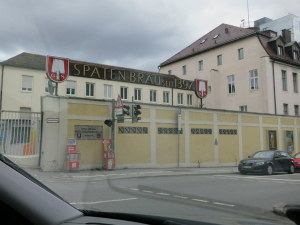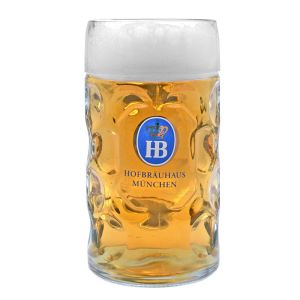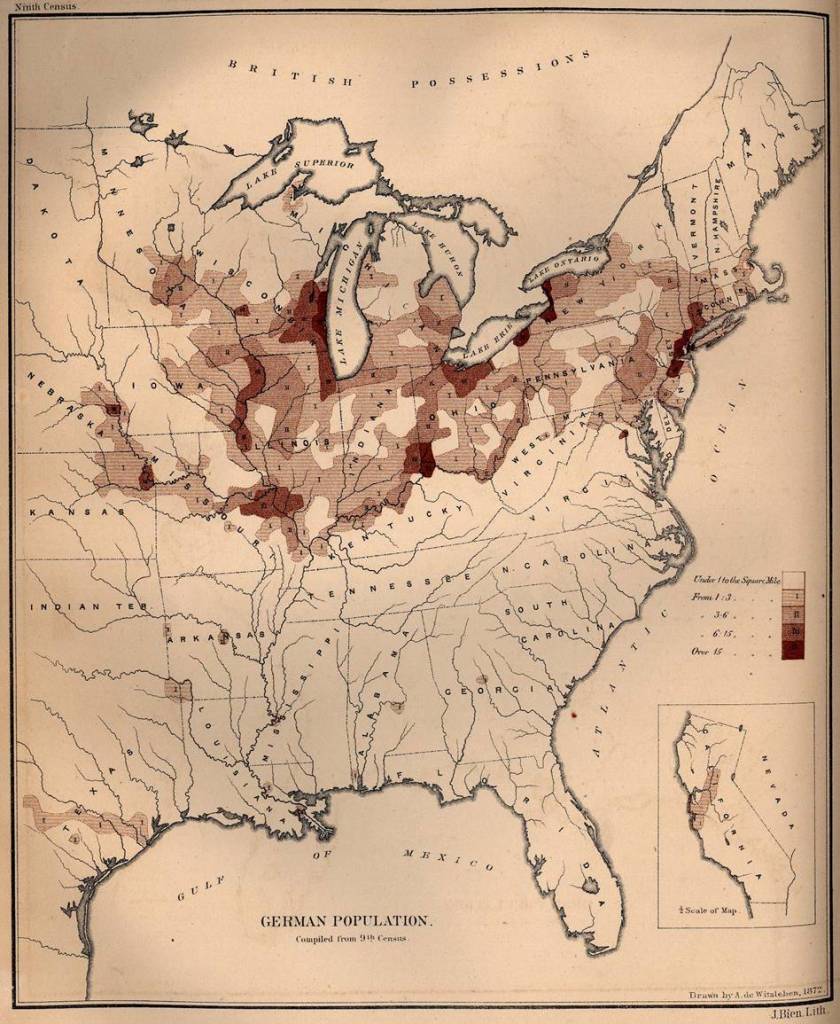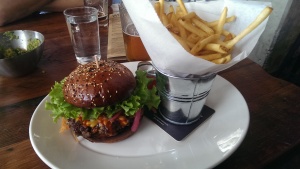![IMAG0625[1]](https://saintjohnswort.ca/wp-content/uploads/2014/11/IMAG06251-1024x579.jpg)
As far as I can tell, every single brewery is issued one of these when they get their license. I’ve never been in a brewery that doesn’t have one kicking around. Look at it sometime and note the visible difference in malt colour. A good rule of thumb is that the lighter the malt, the later it was developed.
A lot of the styles that you think of as German beer didn’t exist at the beginning of the 19th century. Altbier existed in Dusseldorf in a broad sense although it would have been different from the versions we get today. Bock had been around for quite a while, with the town of Einbeck claiming its advent in 1351. Dopplebock had been brewed by the Pauline monks from the mid 18th century. By 1798, the Bavarian branch of the Wittelsbach family had decided to allow their monopoly on Weissbier to lapse, giving license to several entities to produce a similar product. In Munich, the prevailing style was Dunkel. People were also making things like Kellerbier and Zwickelbier with bottom fermenting yeast[i], especially in the northern bits of Baden-Wurttemberg and Franconia, but they would have been darker in colour than we are accustomed to.
The thing that these beers have in common is that they are uniformly pretty dark in colour. The Weissbier is the exception that proves the rule. In order to make a beer that was much lighter than 15-20 SRM in the late 18th century in Germany, over 50% of your grist had to be wheat.
The early 19th century created a sort of renaissance for brewing in Europe due mostly to technological advancement. Beer Styles as we now think of them, catalogued by Michael Jackson, are thought of usually as entirely separate entities, but their development exists on a temporal continuum. Usually the development of a new style is influenced by an old style and a new ingredient, process or cultural influence. At the moment, we’ve got hops in a wider variety than has ever existed and that’s due to technology, genetic manipulation and cross breeding.
You’ll recall that there were really only four varieties of German hops. They didn’t have a roadmap for genetic inheritance. There was only one kind of yeast and they didn’t really understand how it worked yet. The water was however it was. The single most important discovery in the entire history of brewing, the one that caused brewers all over Europe to suddenly create new beers, was the ability to reliably heat a kiln to a specific temperature.
A direct fired kiln is not bad for pottery, but it’s terrible for malting. For one thing, it’s extremely inefficient. You’ve got to fire the kiln and then wait for it to get to about the right temperature. You’re more or less guessing about what the temperature is and where it will be over a long period. You’d develop a knack for that eventually, but there’s only so much you can do with it. The lack of precision means that your malt is going to turn out darker than you want and it’s going to take on some flavour from whatever fuel you’re using to heat the malt. If you’re in a place where you’ve got to use wood or peat for fuel that means wood smoke. That’s a geographical problem. If you’re in Upper Canada in 1820 and you’re making your own malt, you probably don’t have access to coke or coal. You were probably using wood or charcoal because there’s lots of it. Slight smoke flavour.
Another way that it’s inefficient is that darker malt is going to tend to have less diastatic power. In order to get the beer to the strength that you want it to be as a finished product, you’re going to have to use more malt. More malt is going to result in the darker beer styles that we’ve already mentioned. It’s quite expensive because you need more barley to make the same amount of beer.

Gabriel Sedlmayr’s Spaten Brewery. Munich Lager changed irrevocably with the adoption of (and improvement on) English malting techniques
By the time that Anton Dreher was a brewing apprentice in the 1830’s, he was touring England to see what techniques they were using. This was pretty common practice amongst brewers in the 19th century. Because no one was in direct competition with each other internationally, trade secrets weren’t particularly highly guarded. By 1836, he had brought English malting techniques back to Schwechat near Vienna. It wasn’t exactly Pale Malt. It was darker than that. It was closer to a light Crystal Malt roast and that’s what’s become known as Vienna Malt.
Informational exchange within the region happened almost immediately because Dreher was friends with the brewmaster at the Spaten Brewery in Munich, Gabriel Sedlmayr. Dreher borrowed Sedlmayr’s yeast and Sedlmayr borrowed Dreher’s malting technique. Informational exchange drives progress in any field, but the string of events these two brewers would put in motion would last until the 1950’s on another continent.
Artistry and refinement happen in German beer as a direct result of modernization of agriculture and industry. You can’t have barley to malt without increased yield and you can’t malt it to any degree of precision with shoddy tools. The hops, yeast and water did not change substantially. The lightening of malt leads to the lightening of beer. The styles exist as a basic continuum because they all result from the previous change. Because of the prevalence of rail and the ability to transport goods, each style inspires the next. They don’t exist in a vacuum.
| Viennas | |||||
| Beer Style | Creator | Date | Avg Bus | Avg SRM | AVG ABV |
| Vienna/Marzen | Anton Dreher | 1841 | 24 | 13 | 5 |
| Marzen/Oktoberfest | Gabe Sedlmayr | 1872 | 24 | 10.5 | 5.25 |
This is the prime example. Functionally there may not be a difference between Marzen and Oktoberfest beer. However, in practice, Oktoberfest beer was introduced by Spaten in 1872 and the primary difference was the fact that they had developed a new malting technique. Instead of Vienna Malt there was Munich Malt. The lightening is only two and a half points on the SRM scale, but that requires a level of precision. How dark can you make the malt and still have diastatic power needed to convert starch to fermentable sugar?
| Lagers | |||||
| Beer Style | Creator | Date | Avg Bus | Avg SRM | AVG ABV |
| Schwarzbier | Kostritzer | 1543 | 27 | 23.5 | 4.9 |
| Dunkel | Munich | 1800 | 23 | 21 | 5.05 |
| Pilsner | Plzen | 1842 | 40 | 4.75 | 4.8 |
| Dortmund | Kronen | 1871 | 26.5 | 5 | 5.4 |
| Northern German Pilsner | Radeberg | 1872 | 35 | 3.5 | 4.8 |
| Munich Helles | Spaten | 1894 | 19 | 4 | 5.05 |
If you start with Black Lager and move through Munich Dunkel which is formalized as a style by 1800, the departure once Dreher imports English malting techniques is pretty staggering. I’d put it to you that while people will talk about soft water and saaz hops, the defining characteristic of Pilsner is that it was nearly 10 SRM lighter than the other beers available during the 1840’s. Yes, it’s hoppy, but it’s also light gold in colour. That’s a huge departure. Northern German Pilsner is lighter and less hoppy. Dortumunder is significantly less hoppy and about the same colour.
The brewers in Munich actually had some difficulty with Helles. Spaten created it and took a great deal of criticism from the other brewers for doing so. They thought that it was too light! They thought that it didn’t have enough character! That’s as light as German beer styles ever went.
As I’ve shown in the previous posts in this series, because German beer and food contain essentially the same seasoning agents as a result of the landrace hops and locally available herbs and spices, we can assume that we’re dealing exclusively with complementary pairings when we look at Oktoberfest food. Ultimately, the result of the beer getting lighter is that the food also gets lighter. The food needs less fat and can stand being less heavily seasoned. Weisswurst, for instance, is invented in 1857. Additionally, because industrialization has provided more quantity of food, the individual meals do not need to be as substantial. More people are working in cities. In point of fact, a lot of people are emigrating; they are Emigrating to America.
To this day, the largest ancestral group in the USA is German. It’s about 17.1%. From about the time of the revolutions in 1848, there was a huge wave of immigration to the United States. You’ll notice that by that time there was already Pilsner and Vienna Lager in Germany. It was fairly widespread and these people would have had context for that. They had seen the lightening of beer. The largest wave of immigrants came later on and they had seen even lighter beers in Germany. By 1900, Milwaukee, Cincinatti, and Cleveland were all at least 40% German. Every large town in the Midwest would have been at least 25-30% German. We’ve heard the names: Anheuser, Busch, Blatz, Schlitz, Pabst, Yeungling.
When you have a population concentration like that, immigrants bring their ideas with them. In this case, they brought their progressively lighter beers along for the ride. If the defining concept of German beer in the 19th century has to do with making a beer that’s lighter in colour, the restraining factor had been how light the colour could be made with malt. Without the restriction of the Reinheitsgebot, these German brewers could pursue making even lighter beers with adjunct grains like corn and rice.
People claim that prohibition was the factor that created light flavourless commoditized beer, that people had gotten used to soft drinks. Really the blame lies with the fascination of making the beer lighter. It’s a construct that depends on industrial production. It was a good idea that got out of hand. In Munich, they had the sense to stop at Helles. In America it spiraled out of control.
By the 1950’s we had light beer and America had thoroughly adapted the German feasting culture that is Oktoberfest. Bratwurst had become hot dogs. Frikkedellen had become hamburgers. What is a chicken finger but an unflattened chicken schnitzel? The commonality between the food and the beer is that they have been reduced to their least flavourful form in order to appeal to the largest number of people. There’s an idea that beer and food pairing is difficult, but it’s the foundation of American popular cuisine. America was a feasting culture, but without flavour and without joy.
We talk about the 3000 brewery mark in terms of craft beer. There’s an idea that it is important that we have reached the number of breweries that existed before prohibition in North America. The fact is though that the makeup of those breweries is significantly different than it would have been before prohibition. The majority of brewers would have been German and would have made lager. It might be time for Craft Beer to attempt to reclaim that heritage, additional ferment times be damned.
[i] A word on yeast: Throughout my career writing about beer, I’ve run into people who are a little confused about bottom fermenting yeast. I have met professionals who think that lager didn’t exist before 1840. Bottom fermenting yeast had been around and in use for a few hundred years before Emil Hansen managed to separate out a pure strain at the Carlsberg labs. I suspect that these are people who are using “lager” and “pilsner” as interchangeable terms.
The real question is how there was suddenly bottom fermenting yeast in the mid 1500’s. I have an elaborate theory involving Saccharomyces Bayanus, Dutch trading ships and the Rhine as a primary trade route to Bavaria. It’s as good as anyone else’s guess.



Anchor brewing on their blog had a theory as to where the lager yeast parent strain came from and how the source was Argentina.
http://www.anchorbrewing.com/blog/lager-the-most-popular-beer-on-the-planet/
It has to be something to do with the Dutch trading fleet, so Argentina is not out of the question. Yeast probably hybridizes as it travels up the Rhine.
Pingback: Beer and Food: Estrella Damm - St. John's Wort